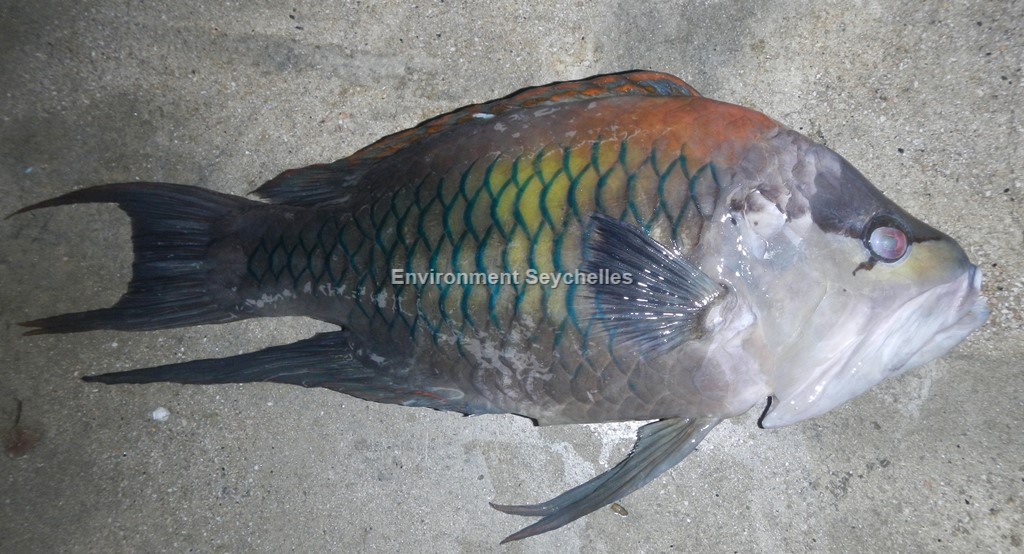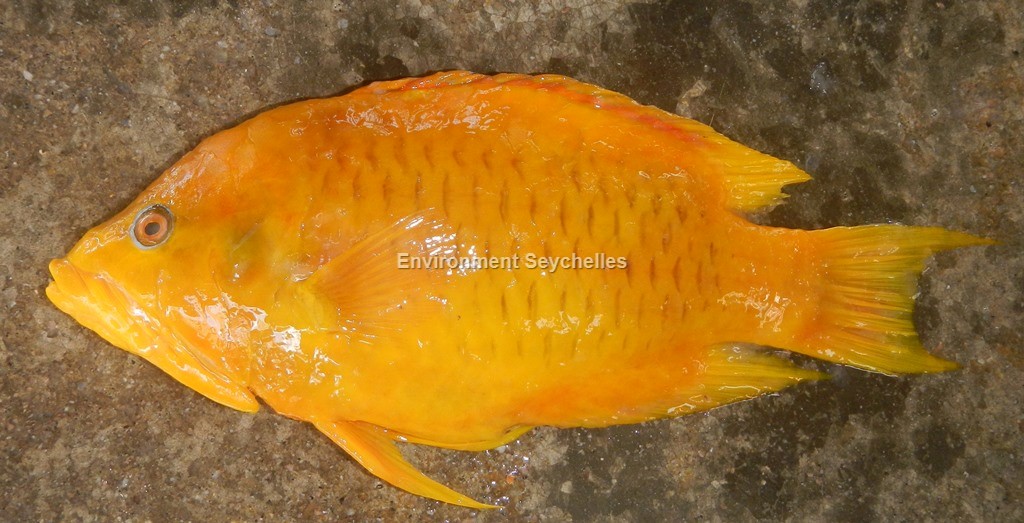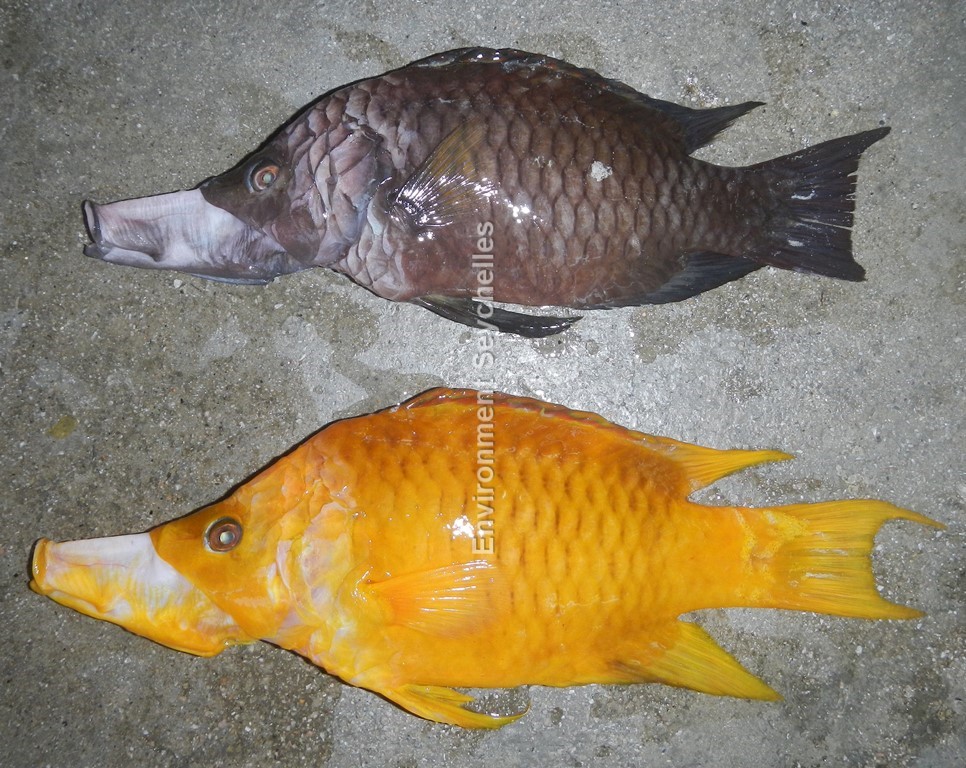Description:
Dorsal spines: 9 -10; Dorsal rays: 9-11; Anal spines: 3; Anal rays: 8-9.
Moderately deep-bodied wrasse, dorsal profile of head convex anterior to dorsal fin, with slight concavity above eye. 2 large canines situated anteriorly in each jaw. Jaws
extremely protrusible, capable of being extended forward more than half the length of the head. The jaws swing forward into a long tube that uses strong suction to catch
prey. Dorsal fin continuous. Pelvic fins filamentous in adults. Caudal fin slightly rounded to truncate with filamentous lobes in adults.
Colour. Varies with age and sex, but adult colour varies additionally, including with an all-yellow xanthic form. Sub adults and females are brown or, not uncommonly,
uniformly yellow. Terminal males are greyish-brown with an orange back, dark scale margins, a yellowish vertical bar on the side, and a pale grey head with a narrow black
stripe through the eye. Small juveniles are brown with thin white bars on the sides and white bars radiating from the eye.
Size:
Maturity: Lm unknown. Range unknown. Max Length: 54 cm SL.
Habitat and Ecology:
Inhabit coral-rich areas of lagoon and seaward reefs commonly at depths of 5-6m (depth range 1-42m). Generally solitary. Feeds mostly on shrimps, crabs and small fishes.
Spawns in harems with male patrolling mating territory. When catching prey, the highly protrusible jaws swing forward into a long tube to suck prey into the mouth.
Fishery Status:
This species is not protected or subject to fishery regulations. It is caught occasionally in the fish trap fishery but more typically in nets that have been dragged on the
substrate, it is usually an uncommon to rare component of the catch.
Notes:
References:
Bray, D.J. (2016). Epibulus insidiator in Fishes of Australia, http://136.154.202.208/home/species/229 (07/03/20).
Froese, R. & D. Pauly. (Eds.) (2019). FishBase. https://www.fishbase.se/summary/5606 (04/06/19).
McGrouther, M. (2019). Slingjaw Wrasse, Epibulus insidiator (Pallas, 1770). Australian Museum. https://australianmuseum.net.au/learn/animals/fishes/slingjaw-wrasse-epibulus-insidiator-pallas-1770/ (07/03/20).
Randall, J.E. (1986). Labridae. p. 683-706. In M.M. Smith and P.C. Heemstra (eds.) Smiths' sea fishes. Springer-Verlag, Berlin.
To, A. et al. (2010). Epibulus insidiator. The IUCN Red List 2010: https://dx.doi.org/10.2305/IUCN.UK.2010-4.RLTS.T187722A8612353.en. (07/03/20).
Citation:
Nevill, J.E.G. (2019). Epibulus insidiator, Slingjaw wrasse. Seychelles Seatizens. www.seatizens.sc. https://seatizens.sc/species/epibulus-insidiator-pallas-1770/ (edited 10/07/22).




pin up 306: pin up kazino – pin-up 141
mexico drug stores pharmacies mexican pharmacy online mexican online pharmacies prescription drugs
pharmacies in mexico that ship to usa: mexican pharmacy northern doctors – mexican border pharmacies shipping to usa
mexico pharmacy: mexican pharmacy northern doctors – purple pharmacy mexico price list
buying prescription drugs in mexico: northern doctors pharmacy – medicine in mexico pharmacies
pharmacies in mexico that ship to usa: Mexico pharmacy that ship to usa – mexican drugstore online
mexico drug stores pharmacies: mexican pharmacy northern doctors – п»їbest mexican online pharmacies
reputable mexican pharmacies online: mexican pharmacy northern doctors – mexican online pharmacies prescription drugs
https://northern-doctors.org/# best online pharmacies in mexico
https://northern-doctors.org/# purple pharmacy mexico price list
best online pharmacies in mexico: northern doctors pharmacy – mexico pharmacy
mexican drugstore online: mexican pharmacy northern doctors – best online pharmacies in mexico
mexico drug stores pharmacies: mexican pharmacy northern doctors – mexican border pharmacies shipping to usa
mexican pharmacy: mexican pharmacy northern doctors – best online pharmacies in mexico
pharmacies in mexico that ship to usa Mexico pharmacy that ship to usa medicine in mexico pharmacies
reputable mexican pharmacies online: mexican northern doctors – mexican rx online
mexico drug stores pharmacies: mexican pharmacy online – medicine in mexico pharmacies
http://northern-doctors.org/# mexican mail order pharmacies
mexican pharmaceuticals online: buying from online mexican pharmacy – mexican border pharmacies shipping to usa
mexico pharmacy: northern doctors – medicine in mexico pharmacies
buying prescription drugs in mexico: Mexico pharmacy that ship to usa – mexico drug stores pharmacies
mexican pharmaceuticals online: northern doctors – mexico pharmacy
https://northern-doctors.org/# mexican pharmaceuticals online
buying prescription drugs in mexico mexican northern doctors medicine in mexico pharmacies
mexican mail order pharmacies: Mexico pharmacy that ship to usa – best online pharmacies in mexico
mexico drug stores pharmacies: reputable mexican pharmacies online – mexico drug stores pharmacies
pharmacies in mexico that ship to usa: Mexico pharmacy that ship to usa – mexican mail order pharmacies
Excellent insights! Your breakdown of the topic is clear and concise. For further exploration, I recommend visiting: READ MORE. Keen to hear everyone’s opinions!
mexican online pharmacies prescription drugs: Mexico pharmacy that ship to usa – п»їbest mexican online pharmacies
http://northern-doctors.org/# п»їbest mexican online pharmacies
п»їbest mexican online pharmacies northern doctors pharmacy mexican rx online
mexico pharmacy: mexican pharmacy online – mexican online pharmacies prescription drugs
https://northern-doctors.org/# best online pharmacies in mexico
mexican border pharmacies shipping to usa: mexican northern doctors – buying prescription drugs in mexico
https://northern-doctors.org/# mexican online pharmacies prescription drugs
buying prescription drugs in mexico online: best online pharmacies in mexico – mexican pharmacy
https://cmqpharma.online/# п»їbest mexican online pharmacies
mexican pharmacy
medicine in mexico pharmacies: cmq pharma mexican pharmacy – mexican rx online
Very interesting subject, appreciate it for putting up.Raise blog range
http://foruspharma.com/# purple pharmacy mexico price list
Online medicine order Online medicine order top 10 online pharmacy in india
pharmacy rx world canada: canadian pharmacy online reviews – canada drugs online review
buying from canadian pharmacies: canadian pharmacy world – global pharmacy canada
certified canadian pharmacy canadianpharmacyworld com pet meds without vet prescription canada
canadian pharmacy prices: canadian drugs pharmacy – canada drugs online
https://foruspharma.com/# reputable mexican pharmacies online
best online pharmacies in mexico: buying prescription drugs in mexico online – buying prescription drugs in mexico
top online pharmacy india buy prescription drugs from india indian pharmacy paypal
online canadian pharmacy review: pharmacies in canada that ship to the us – legal canadian pharmacy online
is canadian pharmacy legit: best canadian pharmacy to order from – legitimate canadian pharmacies
https://canadapharmast.online/# canadian pharmacy
reputable indian online pharmacy: indian pharmacy online – online shopping pharmacy india
https://paxloviddelivery.pro/# paxlovid price
where can i buy cheap clomid: where can i buy clomid prices – generic clomid
http://paxloviddelivery.pro/# paxlovid price
https://paxloviddelivery.pro/# Paxlovid over the counter
Paxlovid over the counter: paxlovid pill – paxlovid cost without insurance
http://ciprodelivery.pro/# ciprofloxacin
buy cheap clomid without dr prescription: where to get clomid without dr prescription – where to buy generic clomid pill
http://amoxildelivery.pro/# where can i buy amoxicillin over the counter
https://clomiddelivery.pro/# order generic clomid online
amoxicillin medicine over the counter: amoxicillin without prescription – amoxicillin pills 500 mg
http://ciprodelivery.pro/# ciprofloxacin order online
http://clomiddelivery.pro/# buy generic clomid without dr prescription
amoxicillin without rx: amoxicillin 500 mg – amoxicillin 775 mg
http://doxycyclinedelivery.pro/# buy doxycycline mexico
amoxicillin 500mg price: amoxicillin no prescipion – amoxicillin for sale online
how can i get clomid without rx: where can i buy generic clomid now – cost of clomid